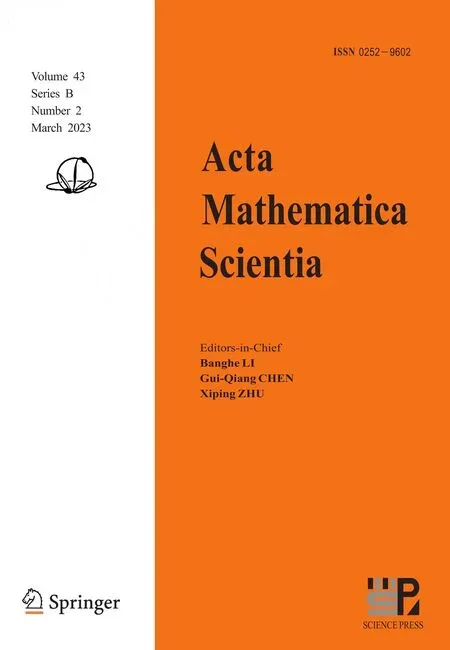NEW DOOB'S MAXIMAL INEQUALITIES FOR MARTINGALES*


Throughout this paper, we denote by C the absolute positive constant that is independent of the main parameters involved, but whose value may differ from line to line.The symbol f ?g stands for the inequality f ≤Cg.When we write f ≈g, this stands for f ?g ?f.
2 Notations and Main Results
In this section, we state some notations and present the main results of the paper.
2.1 Orlicz Functions

(iii) Φ ∈△2if and only if qΦ<∞.Moreover,Φ is said to be strictly convex if pΦ>1.(See [8, 23, 27] for more information on Orlicz functions and the indices.)
2.2 Slowly Varying Functions
A Lebesgue measurable function b:[1,∞)?→(0,∞)is said to be a slowly varying function if, for any given ?> 0, the function t?b(t) is equivalent to a non-decreasing function, and the function t??b(t) is equivalent to a non-increasing function on [1,∞).
A detailed study of Karamata Theory, and the properties and examples of slowly varying functions, can be found in [3, 6, 26].Given a slowly varying function b on [1,∞), we denote by γbthe positive function defined by γb(t)=b(max{t,1/t}), for all t>0.
Proposition 2.1([5]) Let b be a slowly varying function.For any given ?> 0, the function t?γb(t) is equivalent to a non-decreasing function, and t??γb(t) is equivalent to a nonincreasing function on (0,1].
Remark 2.2([5, 32]) Let r >0.Then γb(rt)≈γb(t) for all t>0.
2.3 Orlicz-Lorentz-Karamata Spaces
Now we present a class of new spaces based on the Orlicz function and the slowly varying function.Let (?,F,P) be a complete probability space and let f be an F-measurable function defined on ?.The non-increasing rearrangement f?of f is defined as
with the convention that inf ?=∞.




(3) If Φ(t) = tpfor 0 < p < ∞, then LΦ,q,bis the Lorentz-Karamata space Lp,q,b, which was introduced in [6].The Lorentz-Karamata spaces offer not only a more general and unified insight into Lebesgue spaces, Lorentz spaces, Lorentz-Zygmund spaces (see [2]) and even generalized Lorentz-Zygmund spaces (see [5]), but also provide a framework in which it is easier to appreciate the central issues pertaining to different results; see [5, 7, 10].The study of Lorentz-Karamata spaces has recently attracted more and more attention in martingale theory;see [12, 17, 19, 20].

2.4 Main Results
We shall now establish Doob’s maximal inequality for the Orlicz-Lorentz-Karamata space,which is the main result of this paper.
Theorem 2.5Let 1 ≤q ≤∞, b be a slowly varying function and let Φ be an Orlicz function with pΦ>1.Then we have that
As an immediate application of the last theorem and Remark 2.4, it is easy to conclude and to improve Doob’s maximal inequality on several function spaces for martingales.
Corollary 2.6Let Φ be an Orlicz function with pΦ>1.Then we have that
Remark 2.7We should mention that Liu, Wang and Hou [21] proved (2.2) for when pΦ> 1 and Φ ∈△2.It follows from Corollary 2.6 that, in paper [21], the △2-condition can be removed.
Corollary 2.8Let b be a slowly varying function and let Φ be an Orlicz function with pΦ>1.Then we have that
Corollary 2.9Let p > 1, 1 ≤q < ∞and let b be a slowly varying function.Then we have that
Corollary 2.10Let 1 ≤q < ∞and let Φ be an Orlicz function with pΦ> 1.Then we have that
3 Proof of Main Result



This completes the proof of the theorem.?
 Acta Mathematica Scientia(English Series)2023年2期
Acta Mathematica Scientia(English Series)2023年2期
- Acta Mathematica Scientia(English Series)的其它文章
- MINIMAL FOLIATIONS FORTHE HIGH-DIMENSIONALFRENKEL-KONTOROVA MODEL*
- THE EXISTENCE AND STABILITY OF NORMALIZED SOLUTIONS FOR A BI-HARMONICNONLINEAR SCHRODINGER EQUATION WITH MIXED DISPERSION*
- THE EXISTENCE OF WEAK SOLUTIONS AND PROPAGATION REGULARITY FOR A GENERALIZED KDV sYSTEM*
- A RIGOROUS PROOF ON CIRCULAR WIRELENGTH FOR HYPERCUBES*
- A LARGE DEVIATION PRINCIPLE FOR THESTOCHASTIC GENERALIZED GINZBURG-LANDAU EQUATION DRIVEN BY JUMP NOISE*
- HAMILTON-JACOBI EQUATIONS FOR A REGULAR CONTROLLED HAMILTONIAN SYSTEM AND ITS REDUCED SYSTEMS*
